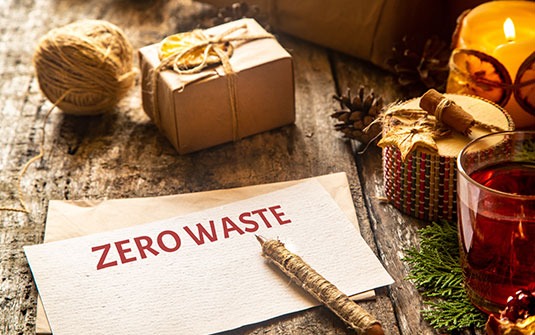DS Smith expert shares top tips to recycle commonly used festive items, from crackers to wrapping paper – and even your tree!
Brits are set to use 300,000 tonnes of card packaging waste this holiday season. Recycling figures from 20231 would suggest that over a quarter of this packaging could end up not being recycled, equivalent to over 515,000 reindeers.2
With the festive period right around the corner, families are getting ready for turkey roasts, presents and decorations, but many Brits can struggle to cope with the volume of packaging that comes with the festive period. From cards and wrapping paper, to crackers and fairy lights, confusion around the rules is causing many recyclable materials to end up in landfills or incinerators.
This comes as statistics show that the UK’s paper and cardboard recycling rate is lagging, with Brits ranking 25th out of 30 European nations for recycling rates at just 73%, compared to the European average of 82%3. Similarly, the UK household recycling rate was 44.1% in 2022, down from 44.6% in 2021.
To help people improve their recycling practices over the festive period, DS Smith’s seasonal sustainability lead, Samantha Upham, shares her top ten tips:
Ten tips to improve your recycling this festive period
Wrapping paper – Not all wrapping paper is recyclable, some contain glitter, or have plastic coatings or attached materials which can contaminate the recycling process.
Samantha’s top tip:“Not sure if your wrapping paper is recyclable? A quick ‘scrunch test’ will tell you: crumple the paper, and if it stays scrunched up, it can be recycled. If it doesn’t stay crumpled it probably has a layer of plastic film so can’t be recycled. If you have doubts about recyclable options, it’s a good start to choose a roll that says it can be recycled.”
Christmas cards – Much like wrapping paper, not all cards can be recycled. While plain card material is recyclable, cards with glitter, plastic badges, or electronics are not. If you can remove these elements, the rest of the card can be recycled.
Top tip: “If you’re faced with a glitter-covered card, don’t just toss it! Any attached pieces can be removed. Once that’s done, you’ve got a recyclable card ready to go. You can also save glitter-free cards for crafting gift tags next year. And remember when purchasing your cards, try and make sure they are glitter free.”
Wrapping tape – Despite common beliefs, not all tape needs to be removed from cardboard before recycling. But the less the better.
Top tip: ” Try switching to paper-based or recyclable tape. It sticks just as well but breaks down far more easily, cutting down your effort and helping to support recycling.”
Christmas crackers – Christmas crackers are often recyclable if they’re made from cardboard but check for glitter or plastic linings. Use the tear test: if it rips easily, it’s probably free of plastic, if not, it can’t be recycled and may have a thicker plastic coating.
Top tip: “Try to choose crackers which don’t have glitter or plastic coatings, there are lots of plastic free options available now. If you’re particularly crafty, you could make your own toys and prizes for family and friends to win.”
Christmas trees – Whilst many opt for a real one, there are many alternatives that can be reused year after year, such as cardboard trees made from recycled material, DIY trees made from fallen branches and crafted wooden trees made from sustainably sourced wood.
Top tip: “If you do opt for a real tree, local tree recycling schemes turn your holiday centrepiece into other useful products. Look for drop-off points near you or use home pickup services.”
Fairy lights – If using battery-operated lights, remember to recycle the lights at dedicated points and bring used batteries to collection points.
Top tip: “Switch to energy-efficient LED lights. They save energy and last longer, reducing waste and cutting your holiday energy bill.”
Gift boxes/bags – Houses are often flooded with boxes from gift giving so reuse leftover gift boxes and bags for future gifting. If you don’t have the storage space, you can break them down to save space in your bins and make recycling easier.
Top tip: “Keep a special box to store reusable gift bags and boxes. You’ll save money and be ready for birthdays and holidays throughout the year.”
Food and drink packaging – Food and drink packaging can pile up during the festive period, but not all of it can be recycled as it is.
Top tip: “Always take off plastic films from food or drink cardboard packaging before recycling and rinse containers which have had food and drink on before putting them in the recycling bin. Don’t forget to leave time for the washed containers to dry! This helps to ensure the recycling process doesn’t get contaminated with non-recyclable materials.”
Advent calendars – Many advent calendars contain a mix of cardboard, plastic, and foil which makes them challenging to recycle. Calendars made entirely of cardboard can usually be recycled, but any plastic windows or glitter should be removed first.
Top tip: “Go for reusable advent calendars that you can refill each year with treats or small gifts. Not only does it cut down on waste, but it also adds a personal touch to your holiday tradition.”
Recycling Rules – Whether you’re home or away during the festive period, make sure to check your local recycling rules and bin collection schedules as they can differ across different regions in the UK.
Top tip: “Check the local council’s website for recycling guidelines and revised bin collection dates over Christmas. Don’t forget to locate the nearest drop-off points as a back-up or if you need more space in your bin for recycling.”




